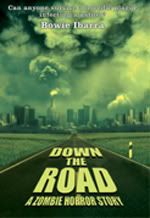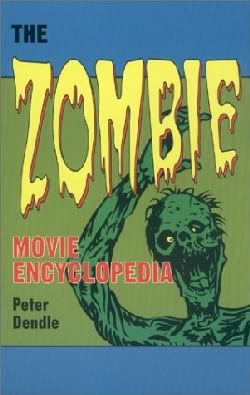I write in my book. I take a pen and mark the hell out of it. This isn't something I would normally do, especially in a book I shelled out $35 for. But I do and I can justify it. How else can I keep track of what I've seen, what I own, what I need to look for? And more importantly, how many more I need to go to catch up with this Dendle fellow? Sometimes you can see me, stalking the video shelves of my local video store, either with the book itself, or with a little scrap of paper, with a dozen titles I could never remember on my own. This is how useful this book has been in my quest to see what I can, as much as I can, good, bad, and ugly.
The back of the book (which features cover art that both repulses and delights at the same time) boasts more than 200 movies. This is not entirely true. There are 194, twelve of which are either shorts or episodes of television series. This error does not detract from the comprehensive guide. Face it. Dr. Dendle is one of the very few (and undoubtedly proud) people who have watched at least 182 zombie films. I mean, really, that is impressive. I have no idea how many zombie films are staggering around out there, but I assume it's quite a few. A
complete reference would not be a book, it would be a numbered set. It would need it's own shelf.
After his acknowledgments, there is the Introduction, which consists of
History and Evolution in five parts. The Early Film Zombie (1932-1952), The 50's and 60's: Tension and Transition (1952-1966), The Stabilizing of the Contemporary Zombie Mythos (1966-present), The Golden Age (1968-1983), and The Mid-80's Spoof Cycle. Sounds very academic, and it is, but fear not, zombie-lover, it's all perfectly understandable. From here he moves onto
Significance, touching upon the zombie's analogous aspects relating to everything from Romero's fight against materialism in
Dawn of the Dead to
Re-Animator's suggested probing into certain concerns in medical science. Dendle then goes on to explain himself in
Definition, Scope and Principles of Selection. This section, if read carefully, will clear up any questions or doubts you might have as to why some films were covered and some were not. There is a method to his madness.
The body of the book itself is
The Films. It is listed alphabetically, including many alternate titles, which refer you to where you want to be. Hence, if you were looking for
Bloodfeast of the Blind Dead and you are looking in the B's, you will find that it directs you to the N's, where you will locate Night of the Seagulls. Does this sound like work? Far from it. With films like
Living Dead at the Manchester Morgue (listed under L for
Let Sleeping Corpses Lie) having seven titles total, you'll be glad to have this handy reference. It might keep you from buying the same movie twice (or more!). Each film is provided with a list of director, producer, screenplay, cast, country of origin (if outside the US), production house and year it was made. If the film's title was originally in another language, that title is also provided. Dendle's reviews are straight forward easy to follow and very often funny. My favorite part of this guide, however, is the fact that each film has a zombie review. Yes, following a description of the film itself is a description of the zombie(s) within. From
The Alien Dead's "zombie with perfect hair and his shirt tucked neatly into his pants" to
Zombie Rampage's "the undead limp along stiff-limbed and contorted, suffering from an epidemic of apoplectic over-acting." From
Garden of the Dead's "their favorite attack is a rather complicated sprint and pick-axe swinging technique" to
La Cage aux Zombies "a transvestite zombie standing around in a bathroom pats himself on the stomach for maybe two full minutes while a woman (well, could be a woman) watches from a wheelchair." Some people like their zombies slow and starchy, while others like them fast and squishy. This guide will help you find the films
you want to see.
When all is said and done, we are provided with two handy-dandy appendices, a bibliography and an index. Appendix A lists films by year from 1932 to 1998, while Appendix B lists them by country (Canada, Egypt, England, Finland, France, Germany, Hong Kong, Italy, Japan, Mexico, New Zealand, Portugal, South Africa, Spain and Thailand...the US is omitted, which might be a loss from those in other countries using this guide.) The Bibliography, which is a wealth of information for anyone looking to become an expert, is broken up into three sections:
Horror Film Guides,
Histories and Encyclopedias,
Studies of Particular Zombie Movies and
Directors and
Zombies and the Living Dead: Folklore and Anthropology. So if there is something you feel Dr. Dendle has missed or excluded, there are sources for this information, but you'll have to do the work. And why not? He did.
I bought my
Zombie Movie Encyclopedia four years ago and still use it actively today in my day-to-day search for zombie fare that I have yet to sink my teeth into. I was able to track down titles that I probably wouldn't have heard of otherwise. I can thank, or blame, Dr. Dendle, depending on what it is I find. The fun, though, is the effort to catch up to him!



